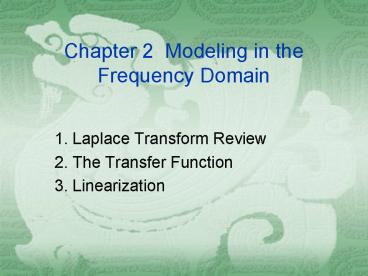Chapter 2 Modeling in the Frequency Domain - PowerPoint PPT Presentation
1 / 39
Title:
Chapter 2 Modeling in the Frequency Domain
Description:
equivalent system at the output after reflection of input torque; c. ... system after reflection of torques and impedances to the output shaft; c. block diagram ... – PowerPoint PPT presentation
Number of Views:341
Avg rating:3.0/5.0
Title: Chapter 2 Modeling in the Frequency Domain
1
Chapter 2 Modeling in the Frequency Domain
- 1. Laplace Transform Review
- 2. The Transfer Function
- 3. Linearization
2
- The Laplace transform is defined as
- The inverse Laplace transform, which allows us to
find - given , is
3
1. Laplace Transform Review
Table 2.1 Laplace transform table
4
Table 2.2 Laplace transform theorems
5
Inverse Laplace Transform
- Partial-Fraction Expansion
- To find the inverse Laplace transform of a
complicated function, we can convert the function
to a sum of simpler terms for which we can know
the Laplace transform of each term. The result is
called a partial-fraction expansion. - Case 1. Root of the denominator are real and
distinct. - Case 2. Root of the denominator are real and
repeated. - Case 3. Root of the denominator are complex or
imaginary.
6
Case 1 Root of the denominator are real and
distinct. where constants
- Case 2 Root of the denominator are real and
repeated. - where constants
7
Case 3 Root of the denominator are complex or
imaginary.
8
2. The Transfer Function
- The transfer function of a linear system is
defined as the ratio - of the Laplace transform of the output variable
to the Laplace - transform of the input variable, with all initial
conditions - assumed to be zero.
- Consider a general nth-order, linear,
time-invariant differential - equation
Figure 2.2 Block diagram of a transfer function
9
Table 2.3Voltage-current, voltage-charge, and
impedance relationships for capacitors,
resistors, and inductors (passive linear
components)
10
Electric Networks
In electric circuits, transfer functions can be
obtained using Kirchhoffs voltage law and
summing voltages around loops (Mesh Analysis)
and/or Kirchhoffs current law and summing
Currents flowing from nodes (Nodal Analysis)
11
Find the transfer function relating the
capacitor, , to the input voltage, .
Figure 2.3 RLC network
Figure 2.5 Laplace-transformed network
Figure 2.4 Block diagram of series RLC
electrical network
12
Figure 2.6a. Two-loop electrical networkb.
transformed two-loop electrical networkc.
block diagram
Given the network of Figure 2.6 (a), find
the transfer function,
13
Figure 2.10a. Operational amplifierb.
schematic for an inverting operational amplifier
c. inverting operational amplifier configured
for transfer function realization. Typically, the
amplifier gain, A, is omitted.
14
Operational Amplifiers
- An operational amplifier has the following
characteristics - Differential inputs,
- High input impedance, (ideal)
- Low output impedance, (ideal)
- High constant gain amplification, (ideal)
15
Figure 2.12 General noninverting operational
amplifier circuit
16
Figure 2.13 Noninverting operational amplifier
circuit for
Find the transfer function
17
Table 2.4Force-velocity, force-displacement, and
impedance translational relationships for
springs, viscous dampers, and mass
18
Figure 2.15 a. Mass, spring, and damper system
b. block diagram
Figure 2.16 a. Free-body diagram of mass,
spring, and damper systemb. transformed
free-body diagram
19
Figure 2.17 a. Two-degrees-of-freedom
translationalmechanical systemb. block diagram
Find the transfer function
20
Figure 2.18a. Forces on M1 due only to motion of
M1b. forces on M1 due only to motion of M2c.
all forces on M1
21
Figure 2.19a. Forces on M2 due only to motion of
M2b. forces on M2 due only to motion of M1c.
all forces on M2
22
Table 2.5Torque-angular velocity, torque-angular
displacement, and impedance rotational
relationships for springs, viscous dampers, and
inertia
23
Figure 2.22 a. Physical system b. schematic
c. block diagram
Find the transfer function
24
Figure 2.23a. Torques on J1 due only to the
motion of J1b. torques on J1 due only to the
motion of J2c. final free-body diagram for J1
25
Figure 2.24a. Torques on J2 due only to the
motion of J2b. torques on J2 due only to the
motion of J1c. final free-body diagram for J2
26
Figure 2.27A gear system
Figure 2.28Transfer functions for a. angular
displacement in lossless gears and b. torque in
lossless gears
27
Figure 2.29a. Rotational system driven by
gearsb. equivalent system at the output after
reflection of input torquec. equivalent
system at the input after reflection of impedances
28
Figure 2.30a. Rotational mechanical system with
gearsb. system after reflection of torques and
impedances to the output shaftc. block diagram
Find the transfer function
29
Figure 2.31Gear train
30
Figure 2.32a. System using a gear trainb.
equivalent system at the inputc. block diagram
Find the transfer function
31
Figure 2.35 DC motora. schematic12b. block
diagram
32
Figure 2.36Typical equivalentmechanical loading
on a motor
33
Figure 2.37DC motor driving a rotational
mechanical load
34
Figure 2.45a. Linear systemb. nonlinear system
35
Figure 2.46Some physical nonlinearities
36
The linearization can obtained using the Taylor
series expansion, which expresses the value of a
function in terms of the value of that function
at a particular point (operation point or
equilibrium point), and derivatives evaluated at
that point.The Taylor series is represented
byFor small excursions of from ,
we can neglect higher-order terms.
Linearization
37
Figure 2.47Linearization about a point A
38
Figure 2.48Linearization of 5 cos x about x
?/2
39
Example Linearize the following
dynamic equation for small excursions about































